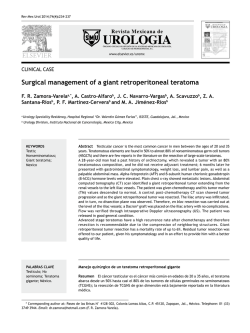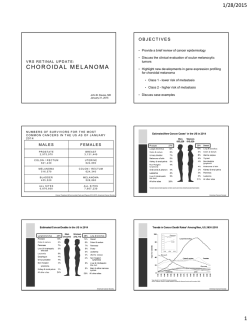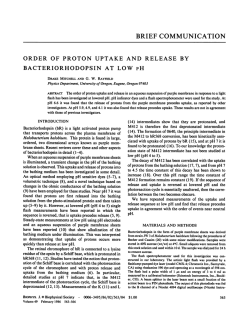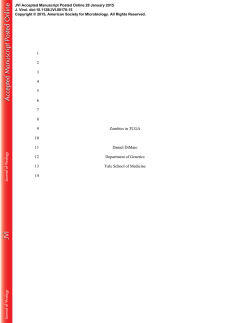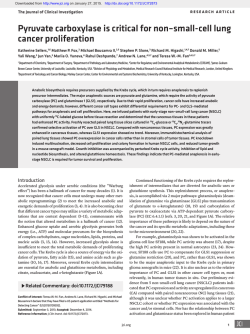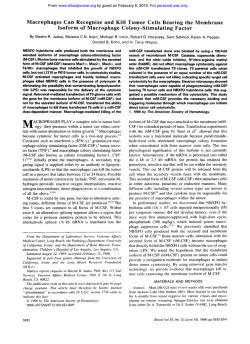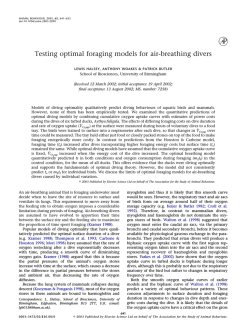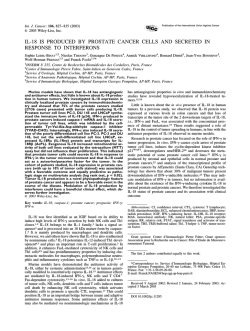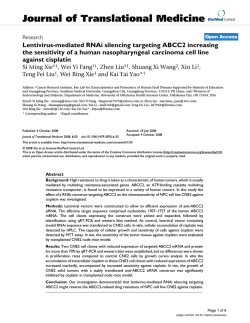
PDF (1.2 MB) - Nuclear Medicine and Biology
Nuclear Medicine and Biology 40 (2013) 795–800 Contents lists available at SciVerse ScienceDirect Nuclear Medicine and Biology journal homepage: www.elsevier.com/locate/nucmedbio Uptake of O-(2-[ 18F]fluoroethyl)-L-tyrosine in reactive astrocytosis in the vicinity of cerebral gliomas Marc D. Piroth a, f, 1, Jeyakamalini Prasath b, f, 1, Antje Willuweit b, f, Gabriele Stoffels b, f, Bernd Sellhaus c, f, Ansel van Osterhout d, Stefanie Geisler b, f, Nadim J. Shah b, f, Michael J. Eble a, f, Heinz H. Coenen b, f, Karl-Josef Langen b, e, f,⁎ a Department of Radiation Oncology, RWTH Aachen University Hospital, Aachen, Germany Institute of Neuroscience and Medicine, Forschungszentrum Jülich, Germany c Institute of Neuropathology, RWTH Aachen University Hospital, Aachen, Germany d Department of Neurosurgery, RWTH Aachen University Hospital, Aachen, Germany e Department of Nuclear Medicine, RWTH Aachen University Hospital, Aachen, Germany f Jülich-Aachen Research Alliance (JARA) – Section JARA-Brain b a r t i c l e i n f o Article history: Received 16 March 2013 Received in revised form 5 May 2013 Accepted 9 May 2013 Keywords: Cerebral glioma PET Astrogliosis O-(2-[18F]fluoroethyl)-L-tyrosine Autoradiography a b s t r a c t PET using O-(2-[ 18F]fluoroethyl)-L-tyrosine (18F-FET) allows improved imaging of tumor extent of cerebral gliomas in comparison to MRI. In experimental brain infarction and hematoma, an unspecific accumulation of 18 F-FET has been detected in the area of reactive astrogliosis which is a common cellular reaction in the vicinity of cerebral gliomas. The aim of this study was to investigate possible 18F-FET uptake in the area of reactive gliosis in the vicinity of untreated and irradiated rat gliomas. Methods: F98-glioma cells were implanted into the caudate nucleus of 33 Fisher CDF rats. Sixteen animals remained untreated and in 17 animals the tumor was irradiated by Gamma Knife 5–8 days after implantation (2/50 Gy, 3/75 Gy, 6/100 Gy, 6/150 Gy). After 8–17 days of tumor growth the animals were sacrificed following injection of 18F-FET. Brains were removed, cut in coronal sections and autoradiograms of 18F-FET distribution were produced and compared with histology (toluidine blue) and reactive astrogliosis (GFAP staining). 18F-FET uptake in the tumors and in areas of reactive astrocytosis was evaluated by lesion to brain ratios (L/B). Results: Large F98-gliomas were present in all animals showing increased 18F-FET-uptake which was similar in irradiated and non-irradiated tumors (L/B: 3.9 ± 0.8 vs. 4.0 ± 1.3). A pronounced reactive astrogliosis was noted in the vicinity of all tumors that showed significantly lower 18F-FET-uptake than the tumors (L/B: 1.5 ± 0.4 vs. 3.9 ± 1.1). The area of 18F-FET-uptake in the tumor was congruent with histological tumor extent in 31/33 animals. In 2 rats irradiated with 150 Gy, however, high 18F-FET uptake was noted in the area of astrogliosis which led to an overestimation of the tumor size. Conclusions: Reactive astrogliosis in the vicinity of gliomas generally leads to only a slight 18F-FET-enrichment that appears not to affect the correct definition of tumor extent for treatment planning. © 2013 Elsevier Inc. All rights reserved. 1. Introduction PET using radiolabelled amino acids is a valuable method to improve the diagnostic accuracy of cerebral glioma in combination with MRI. This concerns in particular an improved delineation of the solid tumor tissue for biopsy guidance and treatment planning [1–7] as well as treatment monitoring, and diagnosis of brain tumor recurrence [8–11]. Amino acid PET is especially helpful to ⁎ Corresponding author. Institute of Neuroscience and Medicine 4, Forschungszentrum Jülich, and Department of Nuclear Medicine, RWTH Aachen University Hospital, D-52425 Jülich, Germany. Tel.: + 49 2461 61 5900; fax: + 49 2461 61 8261. E-mail address: [email protected] (K.-J. Langen). 1 Both authors contributed equally to this work. 0969-8051/$ – see front matter © 2013 Elsevier Inc. All rights reserved. http://dx.doi.org/10.1016/j.nucmedbio.2013.05.001 delineate tumor parts with intact blood–brain barrier that exhibit no enhancement in MRI after application of paramagnetic contrast media and is under clinical evaluation for radiation treatment planning [12–17]. O-(2-[ 18F]fluoroethyl)-L-tyrosine ( 18F-FET) has become a wellestablished 18F-labelled amino acid for PET (half-life, 110 min) that shows logistic advantages for clinical practice compared with the short lived L-Methyl-[ 11C]-methionine ( 11C-MET) (half-life 20 min) [18–21]. Clinical results in brain tumors with PET using 11C-MET and 18 F-FET have been reported to be very similar [22–24]. Although the uptake of radioactive amino acids is considered relatively specific for neoplastic masses, the possibility of non-specific enhancement must be borne in mind. There have been reports of focal 18 F-FET and 11C-MET uptake around hematomas and in cerebral ischemia, as well as tracer accumulation in ring enhancing lesions like 796 M.D. Piroth et al. / Nuclear Medicine and Biology 40 (2013) 795–800 brain abscesses and acute inflammatory demyelination, in sarcoidosis and also in radiation necrosis [25–27]. The cellular components that may cause “false positive” uptake of amino acids in non-neoplastic lesions have been explored in experimental brain injuries in rats such as brain abscesses, cortical infarctions and cerebral hematoma [28–30] and a temporary enrichment of both 18F-FET and 11C-MET was observed in areas with reactive astrocytosis. Reactive astrocytosis is a well-known phenomenon in brain injuries that can also be found in the surroundings of brain tumors [31–33]. Furthermore, radiation therapy is known to evoke cellular responses resulting in astrogliosis [34,35]. Increased 18F-FET-uptake in such areas could lead to an overestimation of tumor size which may be of crucial importance for the use of this method for surgical resection and radiation treatment planning in both primary and recurrent gliomas. The aim of this study was to explore possible “false positive” uptake of 18F-FET in the area of reactive gliosis in the vicinity of untreated and irradiated rat gliomas. 2. Material and methods 2.1. Animals A total of thirty-three male Fischer 344 CDF rats (age 7–11 weeks, weight 200–380 g, Charles River Wiga, Sulzfeld Germany) were used in this study. The experiments were approved by the district govern- ment according to the German Law on the Protection of Animals (Recklinghausen/Germany No. 8-87-50.10.35.08.228). The animals were kept under standard housing conditions with free access to food and water. Brain tumors were produced in all animals as described below. Sixteen tumor bearing rats remained untreated and 17 animals received a single shot radiotherapy. Further details on the timing of the experiments and radiation doses are given in Table 1. 2.2. Cell line and tumor implantation The F98 rat glioma cell line was grown as a permanent cell culture as described previously [23]. F98 tumors have been described histologically as anaplastic or undifferentiated glioma and exhibit an invasive growth pattern and a weak immunogenic response. The biological properties of this cell line closely resemble those of human glioblastoma [36]. The cells were cultured as a monolayer in Dulbecco's modified Eagle's medium high glucose (DMEM) supplemented with 5% (v/v) heat-inactivated fetal calf serum (FCS), 100 units/mL penicillin, 0.1 mg/mL streptomycin and 2 mM glutamate (cell growth medium) in an atmosphere of humidified 5% CO2 at 37 °C. For cell passaging F98 cells were washed with pre-warmed Dulbecco's phosphate buffered saline (DPBS) and trypsinized by using 1-fold trypsin/ EDTA for ~ 5 min at 37 °C. Trypsin was inactivated by adding prewarmed cell growth medium. Table 1 Data on animals with F98 Gliomas. Rat No. RTx-dosea [Gy] Timing of RTxb [d] Autoradiographyc [d] Tumor size [mm] FET uptake Tumor [L/B]d FET uptake Astrogliosis [L/B] 1 2 3 4 5 6 7 8 9 10 11 12 13 14 15 16 17 18 19 20 21 22 23 24 25 26 27 28 29 30 31 32 33 Mean SD 50 50 75 75 75 100 100 100 100 100 100 150 150 150 150 150 150 6 7 7 6 6 5 5 7 7 7 7 6 7 8 8 6 6 6.5 0.9 8 9 9 14 12 11 13 13 14 14 12 12 13 13 13 13 17 12 12 13 13 13 13 12 12 11 11 14 14 13 13 13 13 12.5 1.7 5.4 6.0 4.9 8.2 9.0 6.6 3.6 2.1 9.8 9.4 8.4 6.9 2.5 8.5 3.7 5.3 6.1 5.2 7.6 7.3 8.3 8.2 9.0 2.7 8.1 6.2 5.9 2.7 1.9 9.7 8.3 3.7 5.3 6.3 2.4 5.7 3.9 5.2 3.4 4.1 3.5 2.7 3.0 3.0 3.1 4.0 3.6 4.3 3.5 3.7 4.1 5.1 3.5 5.1 5.0 3.7 7.2 6.2 2.2 3.4 4.3 4.5 2.5 3.6 3.4 4.0 2.5 2.7 3.9 1.1 1.4 1.4 1.6 0.9 2.0 1.2 1.7 1.7 1.2 1.7 1.4 1.8 1.3 1.6 1.4 1.3 1.4 2.1 1.3 1.4 1.5 1.2 1.2 1.2 1.4 1.0 1.2 1.5 1.4 1.0 2.2 2.4 2.6 1.5 0.4 a b c d RTx = radiation dose to the target volume delivered by Gamma Knife. Timing of RTx = time period between tumor implantation and radiotherapy. Autoradiography = time period between tumor implantation and autoradiography. L/B = radioactivity concentration in the lesion divided by normal brain tissue. M.D. Piroth et al. / Nuclear Medicine and Biology 40 (2013) 795–800 797 Fig. 1. Coronal brain slices of a non-irradiated F98-rat glioma after 9 days of tumor growth (rat no. 2). Nuclear staining with DAPI on the left depicts the tumor which shows identical extent in the autoradiography of 18F-FET uptake (middle). GFAP staining marking reactive astrogliosis around the tumor is shown on the right. Arrows indicate areas with strong astrocytosis in the vicinity of the tumor. 18F-FET uptake in that area is not increased. For stereotaxic tumor implantation, animals were sedated in a 2–5% atmosphere of isoflurane and anesthetized subsequently with an intraperitoneal injection of a mixture of ketamine (100 mg/kg bodyweight) and xylazine (10 mg/kg bodyweight). The head was fixed in a stereotactic frame and the skin of the skull was incised to expose the cranial bone. A hole was drilled into the skull with a diameter of 0.9 mm using a micro-drill 2 mm lateral right from the bregma. The F98 rat glioma cells (30000–100000 cells in 5–10 μL) were injected into the right basal ganglia at a depth of 5 mm from the skull surface using a 10-μL syringe. 2.3. Gamma Knife irradiation Seventeen animals were irradiated by a Leksell Gamma Knife® Model B (Elekta AB, Stockholm, Sweden). Six to eight days after tumor implantation the rats were sedated in an isoflurane atmosphere (2%–5%) and were fixed in a dedicated rat positioning system [37]. The device was adapted to the stereotactical frame and was set on the positioning system of the Gamma Knife within an 8 mm collimator helmet. Radiotherapy was performed using a standard treatment plan based on an MRI scan. The images were transferred to the Elekta workstation and co-registrated. The planning process was performed using the Leksell GammaPlan® software (version 5.32). The single isocenter was focused to the left striatum. The radiation doses (50–150 Gy, irradiation time: 47– 86 min) were prescribed to the 90% isodose involving the left hemisphere as target volume. 2.4. Radiotracer The amino acid derivative O-(2-[ 18F]fluoroethyl)-L-tyrosine was produced via aminopolyether supported nucleophilic 18F-fluorination of N-trityl-O-(2-tosyl-oxyethyl)-L-tyrosine tert-butylester and subsequent deprotection with a specific radioactivity of N200 GBq/μmol [38]. The uncorrected yield of tracer was about 35% and radiochemical purity N 98%. The tracer was administered as isotonic neutral solution. 2.5. Autoradiography Eight to seventeen days after tumor implantation the rats were reanesthesized for tracer injection. The majority of animals (n = 30) were sacrificed approximately two weeks after tumor implantation with some variation (11–17 days) due to logistic reasons (availability of 18F-FET synthesis, timing of gamma knife irradiation)(see Table 1). Three animals without radiation therapy (animal no. 1–3) were already investigated at 8 to 9 days after tumor implantation to explore possible differences of 18F-FET uptake in the early phase of tumor growth. The animals received an intravenous injection of 40 MBq 18F-FET via the tail vein. One hour after tracer injection, rats were sacrificed and the brains were removed immediately and frozen in isopentane (2-methylbutane) at − 50 °C. Brains were cut in coronal sections (40 μm thickness) with a cryostat microtome (CM 3050; Leica Mikrosysteme Vertrieb GmbH, Bensheim, Germany). The tissue sections were placed on phosphor imaging plates (BASSR 2025, Raytest-Fuji, Straubenhardt, Germany) within two hours after tracer injection along with in-house made calibrated 18F liver paste standards. Upon exposure, the imaging plates were scanned with a high performance imaging plate reader (BAS 5000 BioImage Analyzer, Raytest-Fuji, Straubenhardt, Germany). Quantitative autoradiograms were generated (Bq/mg wet weight of the tissue) using the software provided by the manufacturer and the known radioactivity concentrations of the standards. The autoradiograms were evaluated by circular regions of interest (ROIs) placed on areas with maximal tracer uptake in the vicinity of the tumors (size: 1 mm 2) and the contralateral normal brain tissue (size: 3 mm 2). Standardized uptake values (SUV) were calculated by normalization of the average uptake in the ROIs of maximal tracer uptake in the lesion (SUVmax) resp. average uptake in the contralateral gray matter (SUVbr) to injected dose and body weight. Lesion to brain Fig. 2. Coronal brain slices of F98-rat glioma after 12 days of tumor growth and 5 days after gamma knife irradiation with 75 Gy (rat no. 19). Tumor extent is identical as depicted by histological toluidine blue staining (left) and autoradiography of 18F-FET uptake (middle). GFAP staining marks reactive astrogliosis around the tumor (right). Areas with strong astrocytosis in the vicinity of the tumor are indicated by arrows, whereas 18F-FET uptake in that area is not increased. 798 M.D. Piroth et al. / Nuclear Medicine and Biology 40 (2013) 795–800 Fig. 3. Coronal brain slices of a 13 days old F98-rat glioma, 6 days after gamma knife irradiation with 150 Gy (rat no. 32). Nuclear staining with DAPI on the left depicts the tumor. Delineation of the tumor is projected onto the autoradiography of 18F-FET uptake (middle, dotted line). Tumor size is overestimated by 18F-FET due to increased uptake in the area of reactive astrogliosis as shown in the GFAP staining (right). ratios (L/B) were calculated by dividing the SUVmax in the lesion by SUVbr. 2.6. Double immunofluorescence labeling and histologic staining Double immunofluorescence labeling was performed to identify specific subtypes of cells involved in the process of tracer uptake. Reactive astrocytes in brain slices were detected by staining for glial fibrillary acidic protein (GFAP) using rabbit anti-rat GFAP polyclonal antibody (1:1000; abcam, Cambridge, UK). As secondary antibodies, goat anti-rabbit Alexa Fluor 568 or goat anti-mouse Alexa Fluor 488 (1:300; Invitrogen, Karlsruhe, Germany) was used. In all slices, cell nuclei were counterstained with 4′6′-diamidino-2-phenylindole hydrochloride (2 μg/mL DAPI; Sigma-Aldrich Chemie GmbH, Munich, Germany). In addition, tissue slices were stained histologically by toluidine blue in serial slices using a standard procedure. 2.7. Anatomical correlations The autoradiograms and tissue stainings were visually compared for tumor extent and tracer uptake, and the maximal diameter of the tumors was measured. To identify discrepancies in tumor extent between the 18F-FET autoradiograms and histologically stained sections a circumference ROI was drawn along the borders of the brain slices and the tumors based on histological stainings (DAPI and toluidine blue). After adapting the size of the corresponding autoradiogram to the circumference region, the tumor ROI was reprojected on the autoradiogram, which allowed the identification of tracer uptake outside the tumor (Fig. 3). to the tumors (L/B: 1.5 ± 0.4 vs. 3.9 ± 1.1) (Fig. 4). ROC analysis yielded an optimal cut-off of the L/B ratio of 2.19 to differentiate between tumor and astrogliosis (area under curve: 0.96; 95% CI: 0.98–1.00; p b 0.0001; sensitivity 98%; specificity 96%). The area of increased 18F-FET-uptake was congruent with histological tumor extent in 31/33 animals. However, in 2 rats irradiated with 150 Gy, prominent 18F-FET uptake similar to that in the tumor was noted in an area of reactive astrogliosis. This “false positive” 18F-FET accumulation led to an overestimation of tumor size in these animals (animal no 32 and 33) (Fig. 3, Table 1). No significant correlation was observed between the radiation dose on the one hand and the size of the tumor, 18F-FET uptake in the tumor or 18F-FET uptake in reactive astrogliosis on the other hand. Nevertheless, tumors with high dose irradiation (150 Gy) showed prominent histological abnormalities indicating the efficiency of irradiation (Fig. 5). The L/B ratio of 18F-FET-uptake in the area of reactive astrogliosis in the vicinity of gliomas was significantly lower than that previously observed in experimental infarction and hematoma (1.5 ± 0.4 vs. 2.2 ± 0.3 and 2.4 ± 1.0, p b 0.01) (Fig. 4). 4. Discussion The results of this study indicate that astrogliosis in the vicinity of cerebral gliomas in rats does not lead to increased 18F-FET uptake in general. Therefore, the 18F-FET-based delineation of tumor volumes in 2.8. Statistical analysis Values are expressed as mean ± standard deviation. Statistical methods used were t-test or Mann–Whitney Rank Sum Test for group comparisons. Correlation analyses were performed with Pearson correlation coefficient. Probability values less than 0.05 were considered significant. The diagnostic accuracy of the L/B of 18F-FET uptake for differentiation of tumor and astrogliosis was evaluated by receiver-operating-characteristic (ROC) curve analyses (SigmaPlot Version 11.0, Systat Software Inc., San Jose, CA). Decision cut-off was considered optimal when the product of paired values for sensitivity and specificity reached its maximum. 3. Results Large F98-gliomas (size 6.3 ± 2.4 mm) were present in all animals. All tumors showed increased 18F-FET-uptake which was similar in irradiated and non-irradiated tumors (L/B: 4.1 ± 1.4 versus 3.8 ± 0.8, n.s.) (Figs. 1–3). As expected a pronounced reactive astrogliosis was noted in the vicinity of all tumors, detected by immunofluorescence staining against GFAP. 18F-FET-uptake was significantly lower in areas of reactive astrogliosis in comparison Fig. 4. Comparison of lesion to normal brain ratios (L/B) of 18F-FET uptake in areas of reactive astrocytosis in the vicinity of F98 gliomas (this study) to those in the vicinity of hematomas [28] or cortical infarctions [30] and in the tumor tissue of F98 gliomas (this study). 18F-FET uptake in the astrogliosis surrounding F98 gliomas is significantly lower than uptake in the tumor area or than uptake in astrogliosis around other lesions. The dotted line indicates the optimal cut-off value of 2.19 (ROC analysis) that separates best between tumor and astrogliosis. M.D. Piroth et al. / Nuclear Medicine and Biology 40 (2013) 795–800 799 Fig. 5. Left: F98 glioma, still displaying high cell density after 50 Gy irradiation (rat no. 17). The nuclei of tumor cells have intact nuclear membranes and normally distributed chromatin. The nuclear/cytoplasmic ratio is shifted in favour of the cell nuclei. The cytoplasmic processes of the cells appear intact and are readily visible. Right: F98 glioma after 150 Gy irradiation (rat no. 28). The nuclei of tumor cells appear rather weakly stained and do not show normally distributed chromatin. In many cells the nuclei also appear somewhat necrotic as a result of irradiation. human gliomas is probably not influenced by unspecific 18F-FET uptake in the area of reactive astrogliosis. These results are in line with a biopsy controlled study in humans which demonstrated a slightly increased 18F-FET uptake in peritumoral tissue with a L/B of 1.2 ± 0.4 which was significantly lower than that of human gliomas (2.6 ± 0.9). In that study, the tumor could be separated reliably from peritumoral tissue using a cut-off value of 1.6 [2]. In our study, the cut-off value as determined by ROC analysis was slightly higher (2.2). This may be explained by higher 18F-FET uptake in the F98 gliomas (3.9 ± 1.1) in comparison to the human study. 18F-FET uptake in the area of astrogliosis in the vicinity of experimental gliomas was only slightly higher than that observed in peritumoral tissue in humans (1.5 ± 0.4 vs. 1.2 ± 0.4). Therefore, the cut-off used for delineating human gliomas in the treatment planning process should rely on the data obtained in humans. It is an interesting finding that 18F-FET uptake in reactive astrogliosis in this rapidly growing brain tumor during the first two weeks is significantly lower than that observed in other experimental brain lesions such as ischemia or hematoma. After focal cortical ischemia we observed 18F-FET uptake in reactive astrogliosis with an L/B ratio N2.0 up to 7 days after ischemia [30]. This abnormal 18F-FET uptake in reactive astrogliosis decreased to L/B ratios of less than 1.6 approximately two weeks after infarction. Similarly, we observed abnormal 18 F-FET uptake in areas of reactive astrogliosis in the vicinity of cerebral hematoma with maximal tracer uptake 5 to 9 days after bleeding [28]. 18F-FET accumulation decreased to normal values 2 to 3 weeks after bleeding although GFAP staining remained positive [28]. It appears that increased uptake of 18F-FET occurs only in certain phases of reactive astrogliosis in the area of brain lesions. Reactive astrogliosis is not a simple all-or-none phenomenon but is a finely gradated continuum of changes that occur in context-dependent manners regulated by specific signalling events [31]. Further studies are needed to explore the specific conditions that induce 18F-FET uptake in reactive astrocytes. Our findings suggest that especially during the phase of acute tumor growth 18F-FET uptake in reactive astrogliosis is generally low and does not influence the definition of tumor volume for therapy planning. On the other hand, in two animals irradiated with 150 Gy we observed high 18F-FET uptake in the area of reactive astrocytosis which led to an overestimation of tumor size based on the 18F-FET autoradiogram. Although this radiation dose is far above the doses applied in humans it demonstrates that under certain circumstances false positive 18F-FET uptake caused by astrogliosis may occur. In a case report, prominent 18F-FET uptake has been reported in a brain lesion in the temporal lobe 15 years after local radiotherapy of an adjacent head and neck tumor [27]. The lesion showed strong astrocytosis and the patient was diagnosed with radiation-induced leukoencephalopathy. This finding indicates the possibility of false positive 18F-FET uptake in late tissue reactions after irradiation. The majority of studies, however, indicate that 18F-FET PET is rather reliable in differentiating recurrent tumor versus posttherapeutic reactive changes. A previous study in rats demonstrated that radiation necrosis induced by proton irradiation (150 or 250 Gy) in healthy rats led to only a slightly increased 18F-FET uptake [39] that did not hamper the differentiation of radiation necrosis from tumor recurrence. Additionally, retrospective studies in humans indicated a high specificity of 18F-FET PET to differentiate recurrent tumor from radionecrosis [10,40]. Furthermore, follow-up studies showed that 18F-FET PET is able to assess treatment response at an early stage of disease and predicts outcome more reliably than conventional MRI [9,11]. Thus, the current clinical studies do not suggest that “false positive” 18F-FET uptake in post-therapeutic changes represents a major problem in clinical practice. 5. Conclusion Reactive astrogliosis in the vicinity of gliomas generally leads to only a slight 18F-FET-enrichment that appears not to affect the correct definition of tumor extent for treatment planning. After high-dose irradiation unspecific 18F-FET uptake in the vicinity of tumors could be observed in single animals, which appears to be of minor relevance in clinical practice. Acknowledgments The authors wish to thank Mr. Michael Schoeneck for technical assistance, Mr. Norbert Hartwigsen, Tanja Juraschek and Larissa Damm for animal husbandry, Mrs. Erika Wabbals, Mrs. Silke Grafmüller and Mr. Sascha Rehbein for technical assistance in radiosynthesis of 18F-FET. References [1] Kracht LW, Miletic H, Busch S, Jacobs AH, Voges J, Hoevels M, et al. Delineation of brain tumor extent with [11C]L-methionine positron emission tomography: local comparison with stereotactic histopathology. Clin Cancer Res 2004;10:7163–70. [2] Pauleit D, Floeth F, Hamacher K, Riemenschneider MJ, Reifenberger G, Muller HW, et al. O-(2-[18F]fluoroethyl)-L-tyrosine PET combined with MRI improves the diagnostic assessment of cerebral gliomas. Brain: a journal of neurology 2005;128: 678–87. 800 M.D. Piroth et al. / Nuclear Medicine and Biology 40 (2013) 795–800 [3] Pauleit D, Stoffels G, Bachofner A, Floeth FW, Sabel M, Herzog H, et al. Comparison of 18F-FET and 18F-FDG PET in brain tumors. Nucl Med Biol 2009;36:779–87. [4] Pirotte B, Goldman S, Massager N, David P, Wikler D, Lipszyc M, et al. Combined use of 18F-fluorodeoxyglucose and 11C-methionine in 45 positron emission tomography-guided stereotactic brain biopsies. J Neurosurg 2004;101:476–83. [5] Piroth MD, Holy R, Pinkawa M, Stoffels G, Kaiser HJ, Galldiks N, et al. Prognostic impact of postoperative, pre-irradiation (18)F-fluoroethyl-l-tyrosine uptake in glioblastoma patients treated with radiochemotherapy. Radiother Oncol 2011;99: 218–24. [6] Floeth FW, Sabel M, Ewelt C, Stummer W, Felsberg J, Reifenberger G, et al. Comparison of 18F-FET PET and 5-ALA fluorescence in cerebral gliomas. Eur J Nucl Med Mol Imaging 2011;38:731–41. [7] Rapp M, Heinzel A, Galldiks N, Stoffels G, Felsberg J, Ewelt C, et al. Diagnostic Performance of 18F-FET PET in Newly Diagnosed Cerebral Lesions Suggestive of Glioma. J Nucl Med 2013;54:229–35. [8] Galldiks N, Kracht LW, Burghaus L, Thomas A, Jacobs AH, Heiss WD, et al. Use of 11 C-methionine PET to monitor the effects of temozolomide chemotherapy in malignant gliomas. Eur J Nucl Med Mol Imaging 2006;33:516–24. [9] Piroth MD, Pinkawa M, Holy R, Klotz J, Nussen S, Stoffels G, et al. Prognostic value of early [18F]fluoroethyltyrosine positron emission tomography after radiochemotherapy in glioblastoma multiforme. Int J Radiat Oncol Biol Phys 2011;80:176–84. [10] Popperl G, Gotz C, Rachinger W, Gildehaus FJ, Tonn JC, Tatsch K. Value of O-(2-[18F] fluoroethyl)-L-tyrosine PET for the diagnosis of recurrent glioma. Eur J Nucl Med Mol Imaging 2004;31:1464–70. [11] Galldiks N, Langen KJ, Holy R, Pinkawa M, Stoffels G, Nolte KW, et al. Assessment of treatment response in patients with glioblastoma using O-(2-18F-fluoroethyl)L-tyrosine PET in comparison to MRI. J Nucl Med 2012;53:1048–57. [12] Grosu AL, Weber WA. PET for radiation treatment planning of brain tumours. Radiother Oncol 2010;96:325–7. [13] Grosu AL, Weber WA, Astner ST, Adam M, Krause BJ, Schwaiger M, et al. 11Cmethionine PET improves the target volume delineation of meningiomas treated with stereotactic fractionated radiotherapy. Int J Radiat Oncol Biol Phys 2006;66: 339–44. [14] Piroth MD, Pinkawa M, Holy R, Stoffels G, Demirel C, Attieh C, et al. Integratedboost IMRT or 3-D-CRT using FET-PET based auto-contoured target volume delineation for glioblastoma multiforme–a dosimetric comparison. Radiat Oncol 2009;4:57. [15] Rickhey M, Moravek Z, Eilles C, Koelbl O, Bogner L. 18F-FET-PET-based dose painting by numbers with protons. Strahlenther Onkol 2010;186:320–6. [16] Weber DC, Zilli T, Buchegger F, Casanova N, Haller G, Rouzaud M, et al. [18F] Fluoroethyltyrosine- positron emission tomography-guided radiotherapy for high-grade glioma. Radiat Oncol 2008;3:44. [17] Piroth MD, Pinkawa M, Holy R, Klotz J, Schaar S, Stoffels G, et al. Integrated boost IMRT with FET-PET-adapted local dose escalation in glioblastomas. Results of a prospective phase II study. Strahlenther Onkol 2012;188:334–9. [18] Langen KJ, Hamacher K, Weckesser M, Floeth F, Stoffels G, Bauer D, et al. O-(2-[18F] fluoroethyl)-L-tyrosine: uptake mechanisms and clinical applications. Nucl Med Biol 2006;33:287–94. [19] Wester HJ, Herz M, Weber W, Heiss P, Senekowitsch-Schmidtke R, Schwaiger M, et al. Synthesis and radiopharmacology of O-(2-[18F]fluoroethyl)-L-tyrosine for tumor imaging. J Nucl Med 1999;40:205–12. [20] Galldiks N, Langen KJ. Use of amino acid PET in the Diagnostic and Treatment Management of cerebral gliomas. Fortschr Neurol Psychiatr 2012;80:17–23. [21] Langen KJ, Bartenstein P, Boecker H, Brust P, Coenen HH, Drzezga A, et al. German guidelines for brain tumour imaging by PET and SPECT using labelled amino acids. Nuklearmedizin 2011;50:167–73. [22] Grosu AL, Astner ST, Riedel E, Nieder C, Wiedenmann N, Heinemann F, et al. An Interindividual Comparison of O-(2-[18F]Fluoroethyl)-L-Tyrosine (FET)- and L-[Methyl-11C]Methionine (MET)-PET in Patients With Brain Gliomas and Metastases. Int J Radiat Oncol Biol Phys 2011;81:1049–58. [23] Langen KJ, Jarosch M, Mühlensiepen H, Hamacher K, Broer S, Jansen P, et al. Comparison of fluorotyrosines and methionine uptake in F98 rat gliomas. Nucl Med Biol 2003;30:501–8. [24] Weber WA, Wester HJ, Grosu AL, Herz M, Dzewas B, Feldmann HJ, et al. O-(2-[18F] fluoroethyl)-L-tyrosine and L-[methyl-11C]methionine uptake in brain tumours: initial results of a comparative study. Eur J Nucl Med 2000;27:542–9. [25] Floeth FW, Pauleit D, Sabel M, Reifenberger G, Stoffels G, Stummer W, et al. 18FFET PET differentiation of ring-enhancing brain lesions. J Nucl Med 2006;47: 776–82. [26] Singhal T, Narayanan TK, Jain V, Mukherjee J, Mantil J. 11C-L-methionine positron emission tomography in the clinical management of cerebral gliomas. Mol Imaging Biol 2008;10:1–18. [27] Pichler R, Wurm G, Nussbaumer K, Kalev O, Silye R, Weis S. Sarcoidois and radiation-induced astrogliosis causes pitfalls in neuro-oncologic positron emission tomography imaging by O-(2-[18F]fluoroethyl)-L-tyrosine. J Clin Oncol 2010;28:e753–5. [28] Salber D, Stoffels G, Oros-Peusquens AM, Shah NJ, Reifenberger G, Hamacher K, et al. Comparison of O-(2-18F-fluoroethyl)-L-tyrosine and L-3H-methionine uptake in cerebral hematomas. J Nucl Med 2010;51:790–7. [29] Salber D, Stoffels G, Pauleit D, Oros-Peusquens AM, Shah NJ, Klauth P, et al. Differential uptake of O-(2-18F-fluoroethyl)-L-tyrosine, L-3H-methionine, and 3Hdeoxyglucose in brain abscesses. J Nucl Med 2007;48:2056–62. [30] Salber D, Stoffels G, Pauleit D, Reifenberger G, Sabel M, Shah NJ, et al. Differential uptake of [18F]FET and L-[3H]-methionine in focal cortical ischemia. Nucl Med Biol 2006;33:1029–35. [31] Sofroniew MV, Vinters HV. Astrocytes: biology and pathology. Acta Neuropathol 2010;119:7–35. [32] Lee J, Borboa AK, Baird A, Eliceiri BP. Non-invasive quantification of brain tumorinduced astrogliosis. BMC Neurosci 2011;12:9. [33] Chekhonin VP, Baklaushev VP, Yusubalieva GM, Pavlov KA, Ukhova OV, Gurina OI. Modeling and immunohistochemical analysis of C6 glioma in vivo. Bull Exp Biol Med 2007;143:501–9. [34] Hwang SY, Jung JS, Kim TH, Lim SJ, Oh ES, Kim JY, et al. Ionizing radiation induces astrocyte gliosis through microglia activation. Neurobiol Dis 2006;21:457–67. [35] Yang T, Wu SL, Liang JC, Rao ZR, Ju G. Time-dependent astroglial changes after gamma knife radiosurgery in the rat forebrain. Neurosurgery 2000;47:407–15. [36] Barth RF, Kaur B. Rat brain tumor models in experimental neuro-oncology: the C6, 9L, T9, RG2, F98, BT4C, RT-2 and CNS-1 gliomas. J Neurooncol 2009;94: 299–312. [37] Im YS, Nam DH, Kim JS, Ju SG, Lim DH, Lee JI. Stereotactic device for Gamma Knife radiosurgery in experimental animals: technical note. Stereotact Funct Neurosurg 2006;84:97–102. [38] Hamacher K, Coenen HH. Efficient routine production of the 18F-labelled amino acid O-2-18F fluoroethyl-L-tyrosine. Appl Radiat Isot 2002;57:853–6. [39] Spaeth N, Wyss MT, Weber B, Scheidegger S, Lutz A, Verwey J, et al. Uptake of 18Ffluorocholine, 18F-fluoroethyl-L-tyrosine, and 18F-FDG in acute cerebral radiation injury in the rat: implications for separation of radiation necrosis from tumor recurrence. J Nucl Med 2004;45:1931–8. [40] Rachinger W, Goetz C, Popperl G, Gildehaus FJ, Kreth FW, Holtmannspotter M, et al. Positron emission tomography with O-(2-[18F]fluoroethyl)-l-tyrosine versus magnetic resonance imaging in the diagnosis of recurrent gliomas. Neurosurgery 2005;57:505–11.
© Copyright 2025
